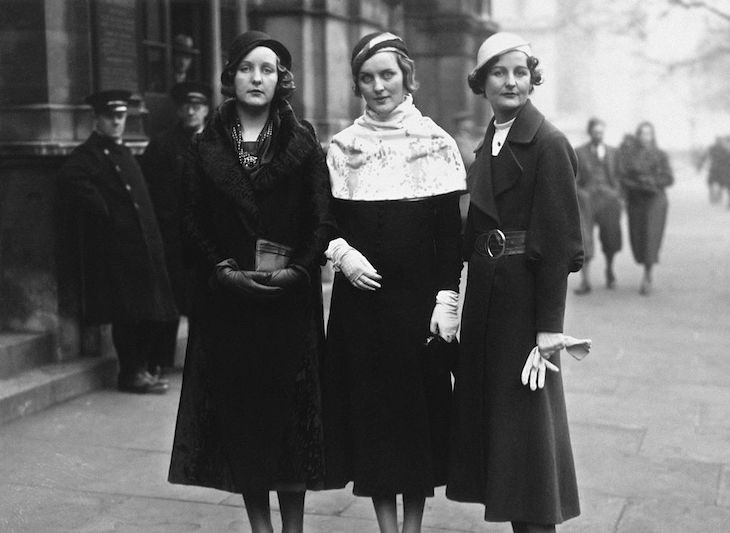Nancy, the first – and perhaps most famous – of the six Mitford girls, died half-a-century ago on 30 June. The lives of the Mitford sisters seem as remote today as Jane Austen’s Bennett sisters. It is almost impossible to separate the family from their fictional equivalents. The books that made them so, Nancy’s The Pursuit of Love and Love in a Cold Climate, have become classics, still in print today, creating cult figures of her already notorious family.
The intensely autobiographical nature of her fiction might suggest a lack of creative imagination but the real-life models she was so brilliantly able to draw on – with little embellishment – made it all the more fascinating for appearing to be true. Published in December 1945, The Pursuit of Love, an hilarious, high-spirited and sweepingly romantic tale came at just the right time to a country exhausted and numb after six years of war. That spirit in a setting of country house madness makes it still so eminently readable. Bristling, philistine Matthew Radlett (Lord Alconleigh) is Nancy’s father and supremely detached Aunt Sadie is a – less sympathetic – portrait of her mother. Both the heroine’s husbands are milder composites of Nancy’s unsatisfactory husband, Peter Rodd (Prodd).
Nancy trumped her success with Love in a Cold Climate four years later; again drawing on life with the Radletts, but focussing on their neighbours – Lady Montdore (a version of her mother-in-law), and Cedric Hampton, the image of Bright Young Thing, Stephen Tennant. But the figure who inspired Nancy and appeared, in one guise or another, in all her writing was Charles de Gaulle’s chef de cabinet, Colonel Gaston Palewski. They met in 1942 and she fell irrevocably in love – with him, and France. He was Fabrice, duc de Sauveterre, in both of her best novels. In her later, engaging but less successful fiction, The Blessing (1951), and Don’t Tell Alfred (1960), he is Charles-Edouard du Valhubert, a charming aristocratic roué.
Her ability to shriek in the face of pain and loss never faltered
When she turned to biography, the Colonel kept appearing – as Louis XV in Madame de Pompapour (1954) and Louis XIV in The Sun King (1966). There were even glimpses of him in Voltaire in Love (1957). The family began to call Nancy the French Lady Writer; her work, suffused with her breathless, idiosyncratic style (the duc de Richelieu was ‘perfectly odious’; Pompadour found many French customs ‘too common for words’). Her histories masked months of solid research; no mean feat for a gel who wasn’t allowed to go to school. As her best biographer, Laura Thompson, says in Life in a Cold Climate (2003), so strong and consistent is Nancy’s voice throughout her work that to snatch and read at random sentences from any of her books is ‘like looking at the six faces of the Mitford girls..’
Another genre where Nancy shone was her journalism (collected as A Talent to Annoy in 1986). Her regular pieces from Paris were essentially a string of teases, the most provocative ‘The English Aristocracy’ (later part of Noblesse Oblige in 1956) where she laid down the law on what was acceptable in upper-class speech, giving birth to U and Non-U. While Nancy quietly revised her early fiction, turning mantelpieces into chimneypieces, mirrors to looking glasses, and notepaper to writing paper, letters poured into the press. Nancy soon tired of the controversy but enjoyed Osbert Lancaster’s cartoon of a white-tied gent at a ball, ‘I’m dancing with tears in my eyes ‘cos the girl in my arms isn’t U’.
Nancy also poured her genius into her correspondence. Her niece, Charlotte Mosley, edited three volumes: Love from Nancy (1993); her letters to and from Evelyn Waugh (1996); and, in 2007, The Mitfords: Letters Between Six Sisters. Here was the Mitford voice all but loorrst (as the between-the-wars Mitford drawl would have it), the endless teases, the shrieks, the floods they all shared; and Nancy at her witty, worldly, sharp-eyed, sharp-tongued best.
Her ability to shriek in the face of pain and loss never faltered, despite an agonising four-year battle with (then undiagnosed) Hodgkin’s disease and the colonel’s marriage, in 1969, to a divorced duchesse (having told Nancy for years that he could not marry a divorced protestant). She managed to finish Frederick the Great in 1970 and to write letters that sparkled and stung to the end.
On 30 June 1973, the colonel was driving on the outskirts of Versailles (where Nancy lived) and had a strong presentiment that he should go to her. He went straight upstairs, his spaniel running ahead as she always did. Nancy was apparently unconscious but she smiled as he took her hand. She died a few hours later; an ending as poignantly romantic as any she could have written and one that underlined the links between her life and her art.






Comments